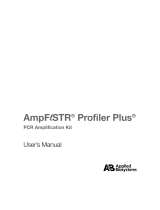Page is loading ...

User Bulletin
ABI PRISM® 377 DNA Sequencer
ABI™ 373 DNA Sequencer with XL Upgrade
June 2, 1998 (updated 04/2001)
SUBJECT: Cleaning Glass Plates to Eliminate Temporary
Loss of Signal
Overview The loss of signal for a short period of time is a phenomenon that
occurs sporadically on ABI PRISM 377 and ABI 373 instruments. It
occurs during runs for both ABI PRISM® DNA Sequencing Analysis
and GeneScan® Analysis Software applications.
This problem manifests itself as a band of little or no signal across the
entire width of the gel image. It usually occurs between 140 to 200
base pairs, and typically lasts the equivalent of 20 to 40 base pairs.
Following this band, signal strength usually returns to normal.
Corresponding electropherograms show a decline in peak intensity to
background levels, usually returning to normal peak heights 20 to
40 base pairs later.
In the past, solutions for solving this problem have included:
♦Replacing reagents
♦Replacing glass plates
♦Cleaning glass plates with a mild acid wash
In most cases, however, the problem returned. Sometimes it was
even worse than before, particularly when mild acid washes were
performed. Consequently, we have continued researching the cause
of this problem.

Page 2 of 4 User Bulletin User Bulletin: Cleaning Glass Plates
Research Results
Contaminant
Molecules
Detected
During our analysis of glass plates used when this phenomenon
occurs, a series of contaminant molecules attached to the surface of
the plates were detected. These contaminants include surfactants,
fatty acids, and long chain polymers.
We believe that the accumulation of one or more of these
contaminants leads to the occurrence of temporary loss of signal.
Furthermore, we suspect that acid washes only add to the
phenomenon by creating more hydroxyl groups on the plate surface
to bind the contaminating molecules.
Rinsing Glass
Plates with Hot
Deionized Water
Rinsing glass plates with hot deionized water was found to effectively
remove suspect contaminants from glass plates, thereby eliminating
the temporary loss of signal. Deionized water raised to a temperature
of 195°F (approximately 90°C) was used for our tests.
We also found that the use of detergents such as Multi-Terge, Alcojet,
and Alconox is not necessary.
The critical parameters for effectively cleaning plates are:
♦Quality of the deionized water used
♦Water temperature, pressure, and volume
♦Consistency
Using a
Dishwasher
We found that cleaning glass plates in a laboratory dishwasher with a
hot deionized water rinse cycle is the most effective means of
consistently and thoroughly removing surface contaminants, thereby
eliminating temporary loss of signal.

User Bulletin User Bulletin: Cleaning Glass Plates Page 3 of 4
Recommendations for Cleaning Glass Plates
Use a Dishwasher We strongly recommend cleaning glass plates in a laboratory
dishwasher with a hot (at least 195°F/90°C) deionized water rinse
cycle. Using a dishwasher helps ensure glass plates are cleaned
effectively and consistently every time. Deionized water is required for
the rinse cycle only.
Additional recommendations:
♦Connect the dishwasher to a high-grade, deionized water source.
♦Clean plates as soon as possible once the gel is removed.
♦Rinse residual gel from plates before loading in a dishwasher.
♦Initially use the longest deionized water rinse option on the
dishwasher, followed by a drying cycle. After some
experimentation, you may be able to reduce the rinse time.
♦Do not use a detergent.
♦Avoid excessive handling of dry plates with ungloved hands.
Recommended
Dishwashers
The following dishwashers have been found to work well. A
customized plate rack may be required.
Item Part Number Supplier
Lancer 1600
dishwasher with
facility for drying
Lancer 1600 UP Lancer USA Inc.
705 West Highway 434
Longwood, Florida 32750
Telephone: 407-332-1855
Lancer UK Ltd.
1 Pembroke Avenue
Waterbeach, Cambridge
CB5 9QR
Telephone: 44-01223-861665
Fax: 44-01223-861990
Sequencing plate
rack for Lancer
dishwasher
(50 plate capacity)
SPR 16 Lancer USA Inc. as listed
above

Labconco
Undercounter
SteamScrubber
Washer/Dryer
15-352-801 Fisher Scientific
U.S. Headquarters
585 Alpha Drive
Pittsburgh, Pennsylvania
15238
Customer Service:
1-800-766-7000
Fax: 1-800-926-1166
Internet:
http://www.fishersci.com
Item Part Number Supplier
© Copyright 2001, Applied Biosystems. All rights reserved.
ABI PRISM, the ABI PRISM design, Applied Biosystems, and GeneScan are registered trademarks of Applera Corporation or its
subsidiaries in the U.S. and certain other countries.
All other trademarks are the sole property of their respective owners.
P/N 4306162 Rev. B, Stock No. 237843-002
/










